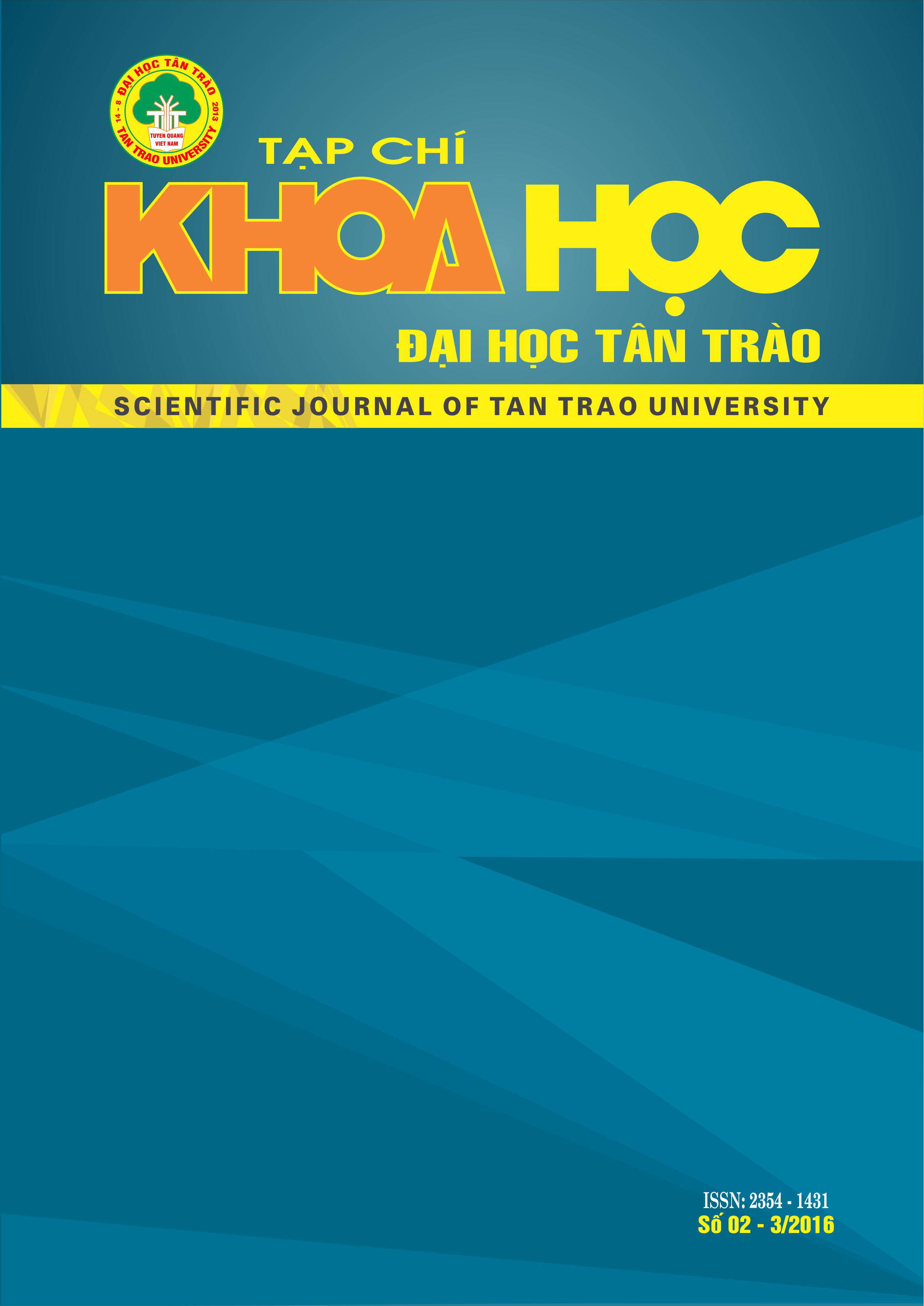Chương trình giáo dục Đại học – trên bình diện quốc tế
DOI:
https://doi.org/10.51453/2354-1431/2016/81Từ khóa:
chÆ°Æ¡ng trình; giáo dục Äại há»c toà n cầu; các yếu tố quốc tếTóm tắt
Chương trình được hiểu một cách rộng rãi là một cấu trúc chưa hoàn chỉnh ở giáo dục Đại học. Bài viết này nghiên cứu về bản chất của chương trình. Các yếu tố liên quan đến mục đích, cấu trúc, thiết kế, truy cập, công nghệ, sự lựa chọn, sự cạnh tranh, giao tiếp và sự cân bằng được xem xét một cách căn bản qua các minh chứng mang tính quốc tế. Một sự xem xét toàn diện về chương trình sẽ mang lại một sự liên kết để cùng mang lại các yếu tố về cơ hội học tập điều mà các cơ sở đào tạo Đại học mang đến cho sinh viên.
Tải xuống
Tài liệu tham khảo
1. ABC Fact Check.Will Australian universities ‘slide into mediocrity’ without reform Retrieved September 25, 2014, from http://www.abc.net.au/news/2014-09-21/christopher-pyne universities-claim-far-fetched/5703522
2. Academic Rankings of World Universities. Retrieved October 6, 2014, from http://www.shanghairanking.com/ARWU2014.html
3. Bastedo, M.N. (2005). Curriculum in Higher Education – The Historical Roots of Contemporary Issues. In Altbach, P.G., Berdahl, R.O. and Gumport, P.J. (Eds.), American Higher Education in the Twenty-First Century (pp 462-485). Baltimore: The Johns Hopkins University Press.
4. Barnett, R..&Coate, K. (2005) Engaging the Curriculum in Higher Education. Maidenhead: SHRE/Open University Press.
5. Bobbitt, J.F. (1918) The Curriculum. Boston: Houghton Mifflin.
6. Curriculum. Retrieved 25 September, 2014, from http://en.wikipedia.org/wiki/Curriculum
7. Dictionary.comCurriculum. Retrieved 25 May, 2007, from Dictionary.com Unabridged (v1.1)
8. Dictionary.com Curriculum. Retrieved 29 September, 2014, from http://dictionary.reference.com/browse/curriculum?s=t
9. Dili Institute of Technology. Retrieved 9 October, 2014, from https://www.facebook.com/DIT.TL/info
10. EDUCAUSE. 7 things you should know about flipped classrooms. Retrieved 6 October, 2014, from https://net.educause.edu/ir/library/pdf/ELI7081.pdf
11. Hicks, O. (2007) Curriculum in higher education in Australia – Hello? Retrieved 28 September, 2014, from content/uploads/conference/2007/PDF/R/p227.pdf
12. Higher Education Academy, Imaginative Curriculum Project.Information and Background. Retrieved 23 March, 2007, from http://www.heacademy.ac.uk/853.htm
13. Higher Education Strategy Group (2011) National Strategy for Higher Education to 2030. Dublin: Department of Education and Skills.
14. La Trobe University, Curriculum White Paper Planning Group (2009). Design for Learning. Bundoora, Victoria: La Trobe University.
15. Lawson, R. (2014).Principles for Designing a Curriculum to Develop and Assure Student Learning Outcomes. Retrieved 6 October, 2014, from http://www.assuringlearning.com/resources/curriculum_design_resources/IICEpaper.pdf
16. Leask, B, and Carroll, J. (2011). Moving beyond ‘wishing and hoping’: internationalization and student experiences of inclusion and engagement. Higher Education Research & Development, 30(5), 647-659.
17. Lee, N. (2011) The Swinburne Professional Learning Model: undergraduate experience as preparation for graduate life. Retrieved 9 October, 2014, fromhttp://www.outduction.ac.uk/kingston-conference/10-00-keynote.pdf
18. Lovat, T.J. & Smith, D.L. (2003). Curriculum – Action on Reflection, 4th ed. Tuggerah: Social Science press.
19. Mooc-List. A complete list of Massive Open On-line Courses offered by the best universities and entities. Retrieved 6 January, 2016, from Mooc-list.com
20. Ranking Web of Universities. Retrieved November 15, 2013, from http://www.webometrics.info/en/node/54
21. The University of Melbourne (2006) The Melbourne Model: Report of the Curriculum Commission. Retrieved September 30, 2014, from http://growingesteem.unimelb.edu.au/_data/assets/pdf_file/0003/86673/cc_report_on_the_mel bourne_model.pdf
22. Times Higher Education World University Rankings. Retrieved 6 October, 2014, from http://www.timeshighereducation.co.uk/world-university-rankings/2014-15/world-ranking
23. Universities Worldwide. Retrieved November 15, 2013, from http://univ.cc/index.html
Tải xuống
Đã Xuất bản
Cách trích dẫn
Số
Chuyên mục
Giấy phép

Tác phẩm này được cấp phép theo Giấy phép Quốc tế Creative Commons Attribution-ShareAlike 4.0 .
Bài báo được xuất bản ở Tạp chí Khoa học Đại học Tân Trào được cấp phép theo giấy phép Ghi công - Chia sẻ tương tự 4.0 Quốc tế (CC BY-SA). Theo đó, các tác giả khác có thể sao chép, chuyển đổi hay phân phối lại các bài báo này với mục đích hợp pháp trên mọi phương tiện, với điều kiện họ trích dẫn tác giả, Tạp chí Khoa học Đại học Tân Trào và đường link đến bản quyền; nêu rõ các thay đổi đã thực hiện và các nghiên cứu đăng lại được tiến hành theo cùng một bản quyền.
Bản quyền bài báo thuộc về các tác giả, không hạn chế số lượng. Tạp chí Khoa học Tân Trào được cấp giấy phép không độc quyền để xuất bản bài báo với tư cách nhà xuất bản nguồn, kèm theo quyền thương mại để in các bài báo cung cấp cho các thư viện và cá nhân.
Mặc dù các điều khoản của giấy phép CC BY-SA không dành cho các tác giả (với tư cách là người giữ bản quyền của bài báo, họ không bị hạn chế về quyền hạn), khi gửi bài tới Tạp chí Khoa học Đại học Tân Trào, tác giả cần đáp ứng quyền của độc giả, và cần cấp quyền cho bên thứ 3 sử dụng bài báo của họ trong phạm vi của giấy phép.


